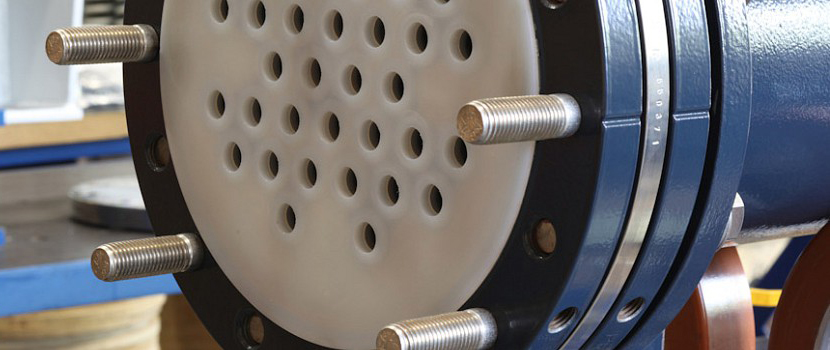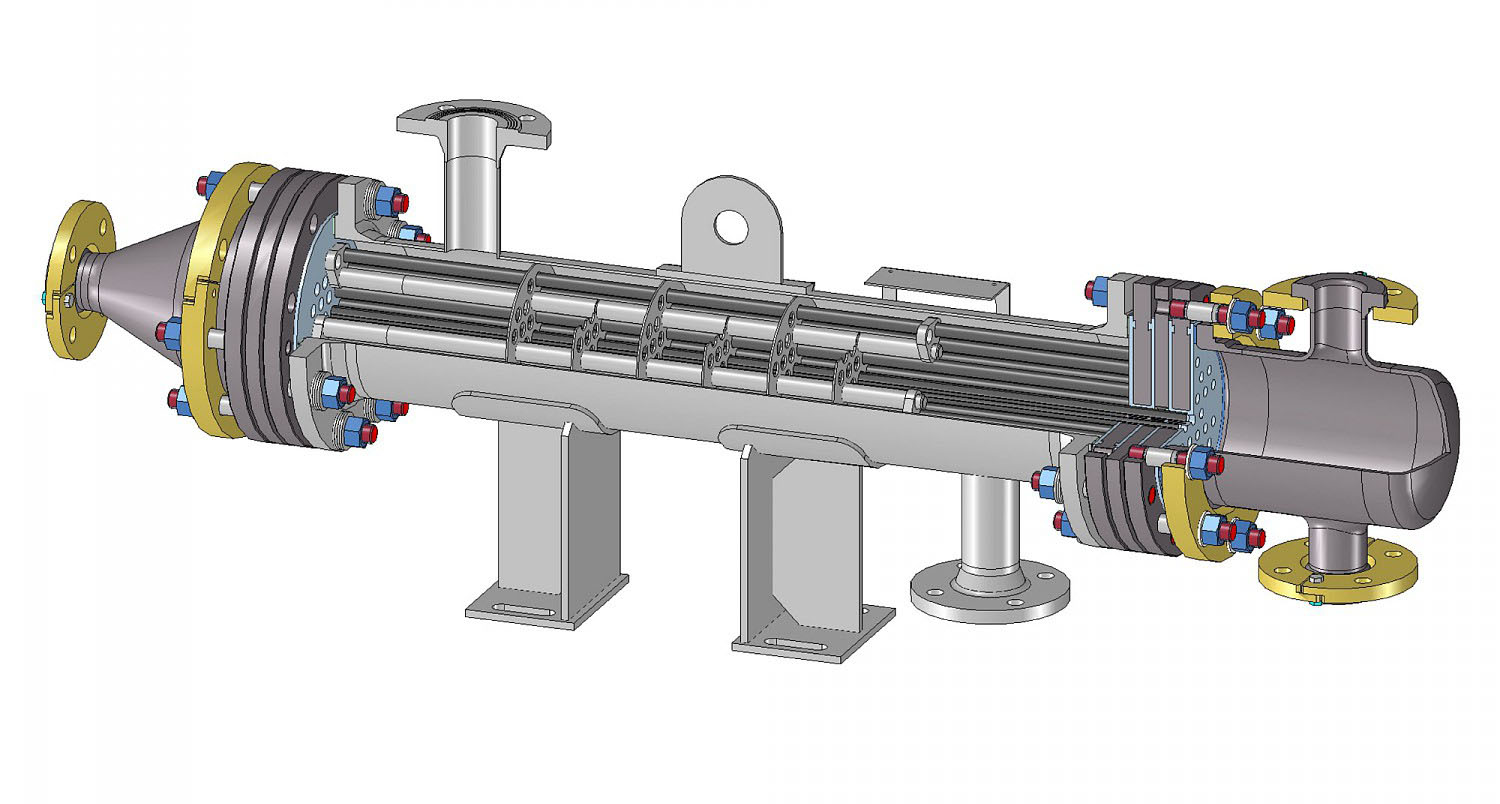Thermal Conductivity: Ranges from 120-200 W/(m·K), enabling high-efficiency heat transfer.
Temperature Resistance: Operates up to 1350°C (2462°F), ensuring reliability under extreme conditions.
Pressure Resistance: Withstands up to 25 MPa (3625 psi), adaptable to various industrial applications.
Corrosion Resistance: Highly resistant to acids and alkalis, offering durability in aggressive environments.
Wear Resistance: Exhibits exceptional durability against abrasive substances, extending service life.
Silicon Carbide Heat Exchangers represent a breakthrough in heat transfer technology, harnessing the exceptional properties of silicon carbide ceramic material. This advanced type of heat exchanger is engineered to meet the demands of industries facing extreme conditions that traditional materials cannot withstand. Silicon carbide's superior thermal conductivity, combined with its remarkable resistance to high temperatures, pressure, and corrosion, makes these heat exchangers ideal for use in challenging environments. They serve as a critical component in processes requiring efficient heat transfer while maintaining resistance to aggressive chemical reactions and physical stresses.

Silicon Carbide Heat Exchangers are constructed from a new generation of engineering ceramic that offers unparalleled performance advantages over conventional materials. The use of high-purity, fine-crystal silicon carbide with a very low porosity results in a material that excels in terms of thermal and mechanical properties. Unlike graphite, stainless steel, metal tantalum, and Hastelloy, silicon carbide does not easily degrade in high-temperature applications, nor does it succumb to corrosion or wear under extreme conditions. This makes it an optimal choice for industries like chemical processing, pharmaceuticals, and metallurgy, where the efficiency and longevity of heat exchange equipment are paramount. The structural integrity of silicon carbide ensures that it can withstand repeated thermal shocks without cracking, maintaining its integrity over a wide range of temperatures and pressures. Furthermore, its chemical inertness allows it to operate effectively in environments that are acidic, basic, or contain aggressive solvents. By leveraging the unique attributes of silicon carbide, these heat exchangers provide a reliable solution for heat transfer applications that exceed the capabilities of traditional materials.
Silicon Carbide Heat Exchangers boast an array of distinctive features that set them apart from traditional heat exchange solutions:
High-Temperature Resistance: These heat exchangers can operate efficiently at temperatures up to 1350°C, making them suitable for high-temperature processes without compromising performance or durability.
Thermal Shock Resistance: Silicon carbide's ability to withstand rapid temperature changes allows these heat exchangers to endure thermal shocks, thereby reducing the risk of cracking and failure in fluctuating thermal environments.
Corrosion Resistance: Exceptional resistance to chemical corrosion from acids, alkalis, and saline solutions ensures that silicon carbide heat exchangers maintain their integrity and functionality in aggressive chemical environments.
Wear Resistance: The inherent hardness and strength of silicon carbide minimize wear and erosion, extending the lifespan of the heat exchangers even under abrasive conditions.
High Thermal Conductivity: With thermal conductivity values significantly higher than those of traditional materials, silicon carbide heat exchangers ensure rapid and efficient heat transfer, contributing to enhanced process efficiency.
Mechanical Strength and Hardness: Silicon carbide's superior mechanical properties provide a robust and durable solution capable of withstanding high pressures and operational stresses.
The utilization of Silicon Carbide Heat Exchangers brings several compelling advantages to industrial processes:
High-Efficiency Heat Transfer: The excellent thermal conductivity of silicon carbide facilitates more efficient heat transfer, resulting in faster processing times and lower energy consumption.
Energy and Fuel Savings: The efficiency of silicon carbide heat exchangers can lead to energy savings, with potential fuel savings exceeding 30%. This contributes to reduced operational costs and a lower carbon footprint.
Enhanced Process Intensification: By enabling higher temperatures and pressures, silicon carbide heat exchangers can intensify processes, leading to increased production capacity and improved process outcomes.
Durability in Harsh Environments: Their superior resistance to thermal shock, corrosion, and wear makes these heat exchangers particularly valuable in harsh industrial environments, reducing downtime and maintenance costs.
Versatility and Compatibility: Capable of handling a wide range of media, silicon carbide heat exchangers are versatile tools for various applications, including aggressive chemicals and high-purity requirements.
The specifications of Silicon Carbide Heat Exchangers can vary depending on the application and design requirements. Typical specifications include:
Dimensions:Customizable to fit specific process requirements, ranging from compact designs for small-scale applications to large units for industrial processes.
Heat Transfer Area: Varied, designed to match the thermal requirements of the process, ensuring efficient heat exchange.
Operating Temperature Range: Typically up to 1350°C, suitable for high-temperature applications.
Operating Pressure Range: Can be designed to withstand high pressures, up to 25 MPa or more, depending on the specific application and construction.
Compatibility with Different Media: Engineered to be compatible with a wide range of media, including highly corrosive chemicals, high-purity fluids, and gases, ensuring versatility across industries.

For the Silicon Carbide Heat Exchanger, a variety of accessories and auxiliary components are available to ensure seamless integration into existing systems, enhance performance, and facilitate maintenance and operation. These include:
Gaskets: High-performance gaskets designed to withstand the operational temperatures and chemical environments of silicon carbide heat exchangers. Material options include PTFE, graphite, and other composites for chemical compatibility and high-temperature resilience.
Brackets and Mounting Hardware: Custom-engineered brackets and mounting solutions that provide secure and stable installation of heat exchangers in various orientations and configurations, accommodating the specific spatial and structural requirements of the installation site.
Temperature and Pressure Sensors: Sensors that monitor the operating conditions of the heat exchanger, ensuring optimal performance and safety. These can be integrated into process control systems for automated monitoring and adjustment.
Flow Control Valves: Valves that manage the flow rate of fluids through the heat exchanger, optimizing heat transfer efficiency and adapting to process demands. Available in materials compatible with the process media and operational conditions.
Insulation Jackets: Removable insulation jackets that reduce heat loss, improve energy efficiency, and protect personnel by lowering the surface temperature of the heat exchanger.
Cleaning Systems: For applications prone to fouling, dedicated cleaning systems, such as chemical cleaning or mechanical brushing units, can be included to maintain heat transfer efficiency and prolong the service life of the exchanger.
Silicon Carbide Heat Exchangers are employed across a wide range of industries, benefiting processes that encounter extreme temperatures, pressures, corrosive substances, and abrasive conditions:
In the production of acids, alkalis, and other chemicals, these heat exchangers withstand corrosive substances, facilitating the transfer of heat in reactors, distillation columns, and other equipment.
For the synthesis and purification of pharmaceutical compounds, where purity and contamination prevention are critical, silicon carbide heat exchangers offer high thermal efficiency and chemical inertness.
In the processing of metals and materials, including steel and aluminum production, these heat exchangers support high-temperature operations and resist the abrasive particles often present in smelting and refining processes.
For flue gas treatment and waste management applications, silicon carbide heat exchangers withstand corrosive components and high temperatures, improving energy recovery and reducing emissions.
Answer: Silicon Carbide Heat Exchangers are engineered to operate efficiently across a wide temperature range. Their design allows for continuous operation at temperatures up to 1350°C (2462°F). This high thermal tolerance ensures that the heat exchangers can handle extreme heating applications, making them ideal for industries with processes involving high-temperature fluids or gases. Their exceptional thermal stability not only facilitates efficient heat transfer but also contributes to the longevity and reliability of the system, reducing the need for frequent replacements or maintenance due to thermal degradation.
Answer: Silicon Carbide Heat Exchangers require minimal maintenance compared to traditional heat exchangers due to their superior resistance to temperature, corrosion, and abrasion. However, regular inspections are recommended to ensure optimal performance and to detect any potential issues early. Maintenance routines might include checking for any signs of mechanical damage, ensuring gaskets and seals are intact, and cleaning the exchanger to prevent fouling. Thanks to the material's properties, cleaning can often be less frequent and less intensive, further reducing operational costs and downtime.
Answer: Absolutely, Silicon Carbide Heat Exchangers are exceptionally suited for use with abrasive media. The material's high hardness and strength make it highly resistant to wear and erosion, which are common issues when handling abrasive substances. This durability ensures that the heat exchangers maintain their efficiency and structural integrity over time, even in applications where particulate matter in fluids or gases might otherwise lead to rapid degradation of less robust materials. As a result, industries dealing with abrasive materials can significantly benefit from the extended service life and reduced maintenance requirements offered by silicon carbide heat exchangers.
Phone:+86-15716151880
Email:[email protected]
Company:BEANT
Address:No. 28, Luoshen Road, Luoshe Town, Huishan District, Wuxi City, Jiangsu Province
